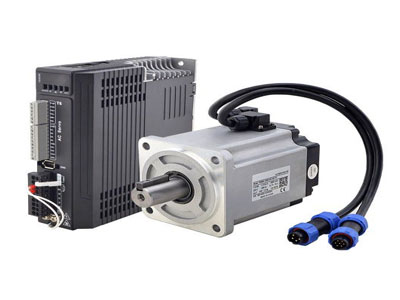Key Takeaway
The main difference between an AC servo drive and a DC servo drive lies in how they handle speed and precision. AC servo drives are ideal for high-speed and high-precision tasks. They work well in applications where you need fast and accurate motor control, such as in robotics or CNC machines.
On the other hand, DC servo drives are better suited for simpler, cost-effective applications. They perform well at lower speeds, making them a good choice for tasks where precision isn’t as critical but reliability and cost-effectiveness are important. Understanding these differences is key when selecting the right servo drive for your specific needs.
Basics of AC and DC Servo Drives
AC servo drives and DC servo drives are designed to control servo motors, but they operate differently based on the type of current they use. AC servo drives operate with alternating current (AC), which means the current periodically reverses direction. This type of drive is known for handling variable speed operations and is often used in applications requiring high precision and reliability. On the other hand, DC servo drives use direct current (DC), where the current flows in one direction. DC drives are generally simpler in design and are typically used in applications where cost-effectiveness and low-speed control are priorities. Understanding these basic differences is the first step in determining which type of drive is best suited for your needs.

Performance Differences Between AC and DC Servo Drives
The performance of AC and DC servo drives varies significantly, making each more suitable for specific tasks. AC servo drives excel in high-speed, high-precision applications due to their ability to handle rapid changes in speed and load. They provide smooth and accurate control, making them ideal for complex automation systems such as CNC machines and robotics. AC drives are also more durable and can operate efficiently under harsh conditions, which adds to their versatility.
In contrast, DC servo drives are known for their simplicity and effectiveness in applications requiring steady, low-speed control. They offer excellent torque at low speeds, which makes them a good choice for tasks like conveyor systems and simple motion control applications. However, DC drives may not match the precision and speed control capabilities of AC drives, especially in more demanding environments. Therefore, the choice between AC and DC often comes down to the specific performance requirements of the application.
Applications Best Suited for AC Servo Drives
AC servo drives are the go-to choice for applications that demand high precision, speed, and reliability. They are commonly used in industries like aerospace, automotive, and electronics manufacturing, where precision machining and fast, accurate movements are crucial. For instance, in a CNC machine, an AC servo drive ensures that the cutting tool moves with pinpoint accuracy, producing components that meet exact specifications. Similarly, in robotics, AC drives control the intricate movements of robotic arms, allowing them to perform complex tasks like assembly and welding with high precision.
Another advantage of AC servo drives is their ability to handle varying loads and speeds, making them ideal for dynamic environments where conditions can change rapidly. Whether it’s in a high-speed packaging line or a robotic assembly unit, AC servo drives provide the flexibility and precision needed to maintain high productivity and quality standards.
Applications Best Suited for DC Servo Drives
DC servo drives are best suited for applications where simplicity, cost-effectiveness, and reliable low-speed control are paramount. They are commonly used in applications like conveyor belts, simple automated machines, and systems where maintaining consistent torque at low speeds is critical. For example, in a conveyor system, a DC servo drive ensures that the belt moves steadily, even when the load varies, providing consistent performance with minimal complexity.
DC drives are also a good choice for educational purposes and experimental setups where ease of use and low cost are more important than high precision. While they may not offer the same level of performance as AC drives in demanding environments, their simplicity and reliability make them a practical choice for many straightforward automation tasks.
Factors to Consider When Choosing Between AC and DC Servo Drives
When deciding between AC and DC servo drives, several factors should be considered to ensure you select the right drive for your application. First, evaluate the performance requirements: if your application demands high precision, variable speed control, and operates in a dynamic environment, an AC servo drive is likely the better choice. However, if your application is more straightforward, with a focus on low-speed control and cost-effectiveness, a DC servo drive may be sufficient.
Another important consideration is the operating environment. AC servo drives are more durable and can handle harsher conditions, making them suitable for industrial settings where reliability is critical. Conversely, DC drives are simpler and easier to maintain, which can be advantageous in environments where ease of use and low maintenance are priorities. Additionally, consider the total cost of ownership, including installation, operation, and maintenance costs, to determine which drive offers the best value for your specific needs.
Conclusion
The choice between AC and DC servo drives depends on the specific needs of your application. AC servo drives offer superior performance in high-precision, high-speed tasks, making them ideal for complex and demanding environments. DC servo drives, on the other hand, provide a cost-effective solution for simpler applications requiring steady, low-speed control. By carefully considering the performance requirements, operating environment, and cost implications, you can make an informed decision that ensures your automation system operates efficiently and effectively.
